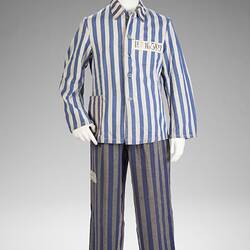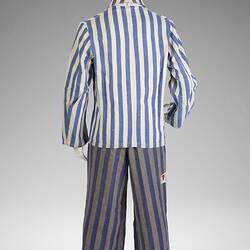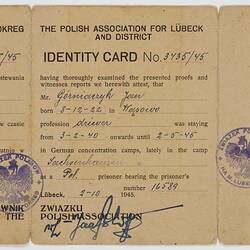Summary
Blue and white uniform worn by Mr Johann (Jan) Gorniaczyk (Gornia) between 3 February 1940 and May 1945 in Nazi concentration camps during World War II. Mr Gornia was born 8 December 1922 in Wasowo, Poland. He spent his imprisonment in Sachsenhausen, Oranienburg in Germany as a non-Jewish political prisoner, number 16589. The inverted red triangle indicates that, according to the Nazi system of prisoner classification, that Mr Gornia was a political prisoner. It is believed that he was incarcerated because his father or uncle had been involved in the Polish uprising against Germany after World War I.
Mr Gornia met his Polish wife Mira in postwar Germany; she had been forcibly taken to a labour camp in Germany and she worked as a nurse in a hospital after the War. Jan and Mira married in Germany and migrated together to Australia in 1949, bringing with them his uniform, along with other war memorabilia. It was then that he officially shortened his name. Mr and Mrs Gornia had one son and lived the majority of their lives in Yarraville, Melbourne. Jan was highly skilled with his hands and worked for Holden.
Physical Description
Uniform comprising a shirt and trousers. The collared shirt is made out of a heavy cotton with a large weave. It has a pocket on the wearer's front right bottom and a cotton hook tag on the back of the collar. It has four metal buttons down its front opening; there is space for five, however the third button down is missing. There is a small, rusted, metal hook clasp at the collar. The shirt has been hand-made on a sewing machine, stitched with white cotton. The pocket has been hand-sewn to the shirt. The shirt and pocket are stripped length-wise, alternating royal blue and white. Each stripe is 18 millimetres wide. The material used on the shirt's body differs from that used on the outside collar, hook tag and pocket. The second material is also striped blue and white of the same width, but the blue is more of an indigo colour. It is unclear whether these sections were sewn on at a later date. The shirt is worn, with several small holes, most notably on the shirt's collar. Several of these holes have been mended by hand. A rectangle piece of white cotton material has been handsewn on the wearer's top left breast, with the wearer's black identification number and identifying upside-down red triangle printed on it. The trousers are made out of a mottled grey wool with 20-millimetre indigo blue stripes, printed on them, length-wise. The trousers are machine-sewn together using a black thread. The trousers fasten at the top with a brown wooden button. The fly closes with three metal buttons and is lined with a light green cotton material. The trousers have two side pockets lined with heavy dark-green cotton material. The trousers have two pleats on their front and five belt loops around the waistband. The inside waistband is lined with finer, smoother, grey material. The trousers are worn, with several small holes, most notably on the crotch. Several of these holes have been hand stitched, in particular, the crotch has been hand-patched with a piece of grey scrap material. A rectangle piece of white cotton material is handsewn on to the wearer's right-side trouser leg, with the wearer's identification number printed on it and an upside-down red triangle sewn on to the same label.
Significance
This collection of wartime memorabilia holds enormous historical significance. These pieces highlight how the Holocaust has involved the lives of innumerable non-Jewish Poles, who experienced incredible levels of inhumanity while imprisoned in concentration and labour camps in Europe. Although the Jewish Holocaust experience is well documented, discourse surrounding the non-Jewish experience is not as prevalent. These pieces help tell this story. Additionally, this collection aids in the understanding of post war immigration to Australia, in this case, of the Polish community to Melbourne.
More Information
-
Collecting Areas
-
Acquisition Information
Donation from Mrs Mira Gornia, 28 May 2010
-
Issued To
Mr Jan Gornia, Germany, 03 Feb 1940
3 February1940 was the date Mr Gornia was imprisoned. No evidence exists to verify if this same uniform was issued at this time. -
Issued By
-
User
-
Inscriptions
Shirt Bold black printed text on the white cotton label: P(red printed triangle)16589 Trousers Bold black printed text on the white cotton label: P(red sewn-on triangle)16589 Bluish handwritten text on the inner waistband: (possibly) A A (illegible)
-
Classification
-
Category
-
Discipline
-
Type of item
-
Overall Dimensions
550 mm (Length), 800 mm (Width), 1690 mm (Height)
Length- shirt shoulder to cuff; Width - widest part of uniform, outer sleeve to outer sleeve; Height - shirt collar to trouser bottom
-
References
Martin Gilbert, Atlas of the Holocaust, Rainbird, 1982. Bill Niven, Facing the Nazi Past, Routledge, 2002 1st ed., p. 11 Evans, Richard J (2006). The Third Reich in Power. London: Penguin Books. pp. 255-256 Adam Lebor & Roger Boyes, Surviving Hitler, Simon & Schuster, pg. 230, 1st ed. 2000 Falk Pingel, Encyclopaedia of the Holocaust, New York: Macmillan, 1990, vol. 4, p.1321-1322 Foot & Langley, 'MI9 - Escape and Evasion 1939 - 1945', Book Club Associates, 1979 [Link 1] [Link 2] [Link 3] [Link 4] [Link 5] [Link 6]
-
Keywords
Brought Goods, Concentration Camps, Holocaust, Identity Badges, Polish Communities, Polish Immigration, Uniforms, World War II, 1939-1945



